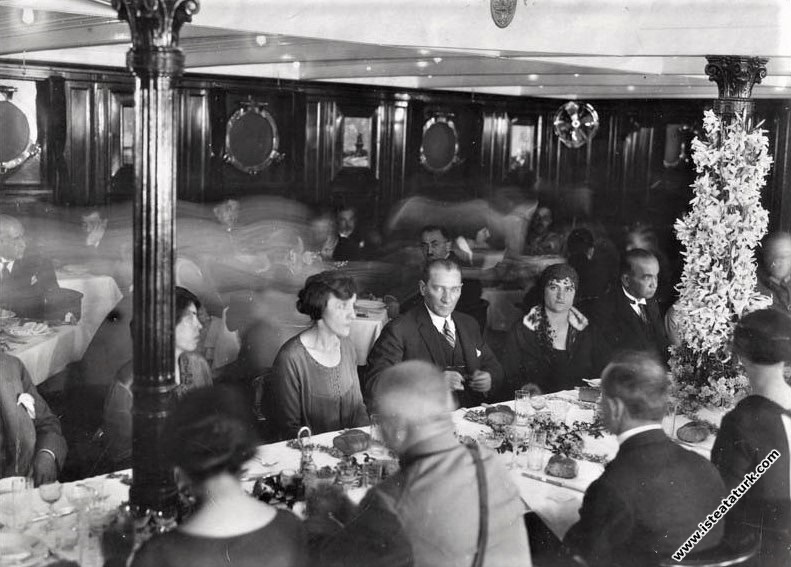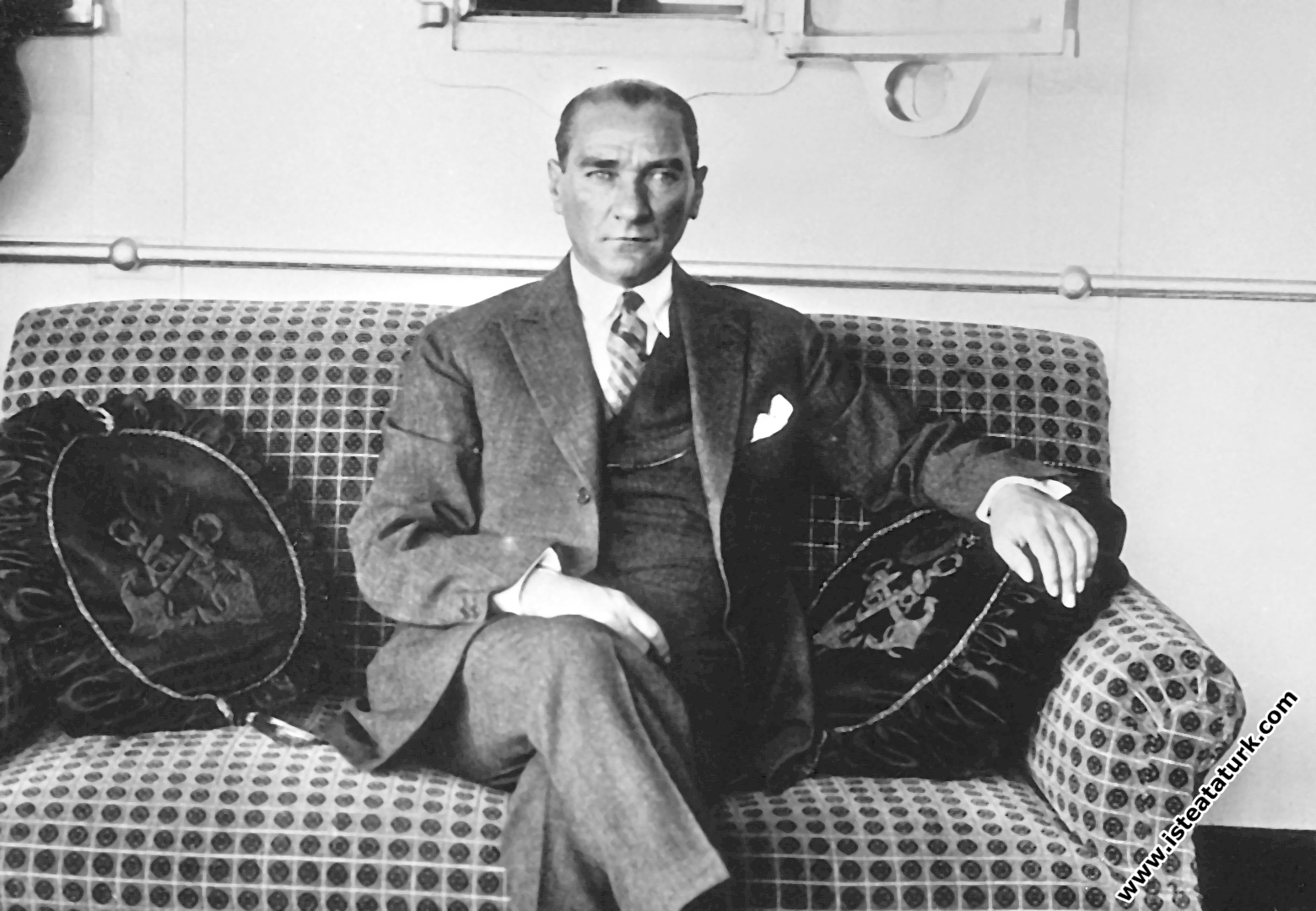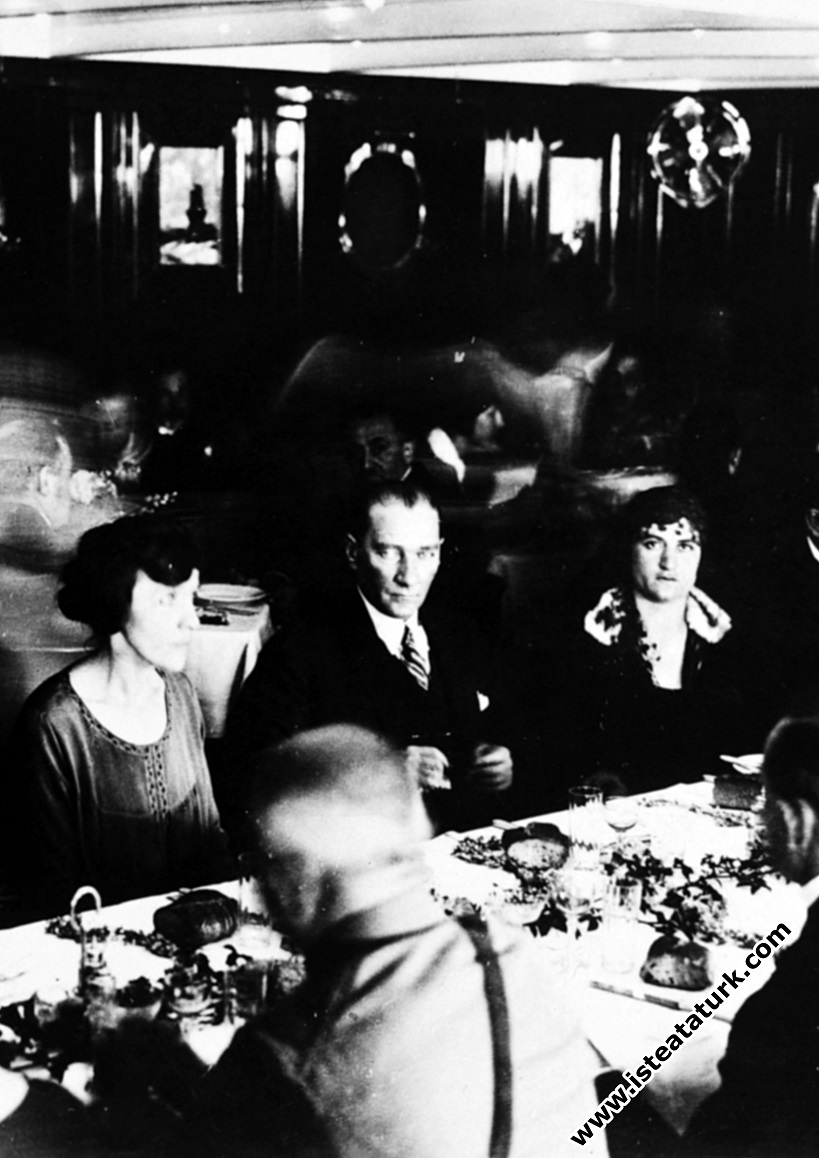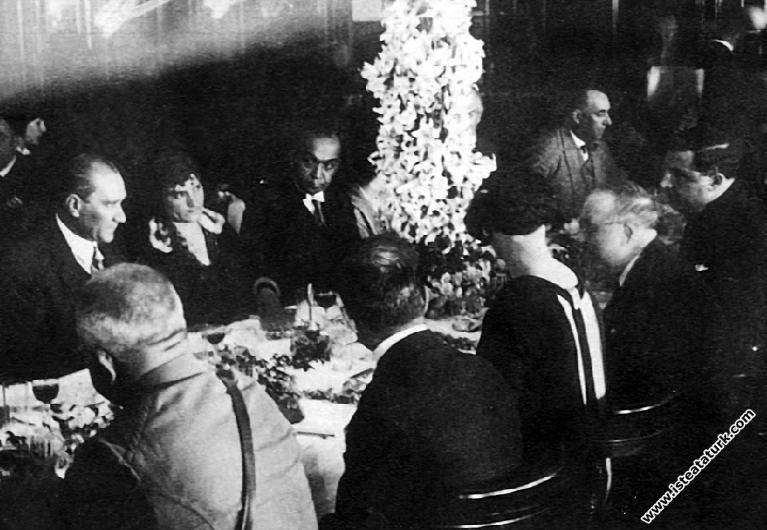Mustafa Kemal Atatürk at lunch on the Black Sea Ferry, Mudanya. (13.06.1926)
Mustafa Kemal Atatürk at lunch on the Black Sea Ferry, Mudanya. (June 13, 1926) ATATÜRK'S PROJECT : A first in the world:
I
ATATÜRK'S PROJECT
A first in the world:
The Black Sea Ferry Project was implemented 3 years after the proclamation of the Republic, upon the recommendation of Atatürk.
The ship, on which various products promoting Turkey were exhibited, visited 16 cities in 12 countries after anchoring in Istanbul on 12 June 1926. After traveling 10 thousand miles in 86 days, the Black Sea Ferry returned to Istanbul on September 5, 1926.
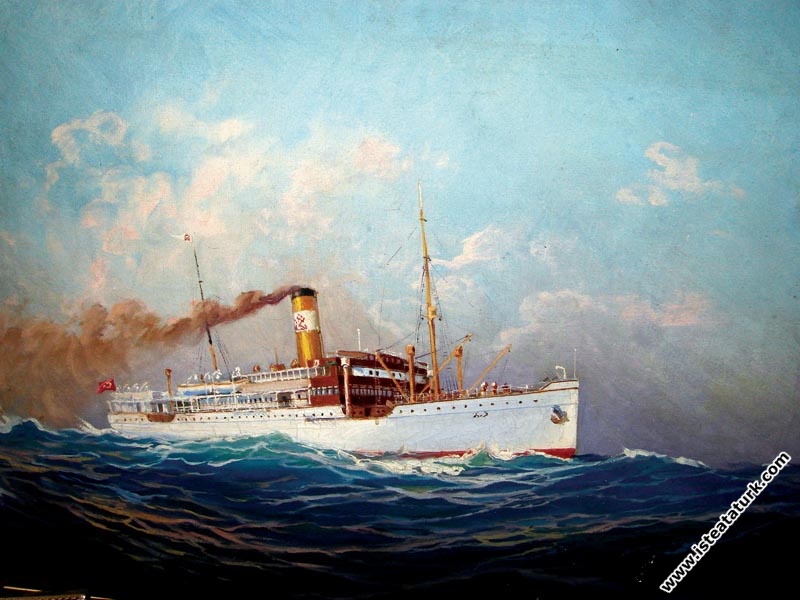
A picture of the Black Sea Ferry
Among the passengers of the Black Sea Ferry were Refi Bayar, son of the 3rd President Celal Bayar, one of the founders of Anadolu Agency, poet Kemalettin Kamu, the composer of the National Anthem, Zeki Üngör, one of the first Turkish women journalists Bedia Arseven, one of the first Turkish women parliamentarians Mebrure Gönenç and the poet Orhan. Veli Kanık's father, musician Veli Kanık, also took part.
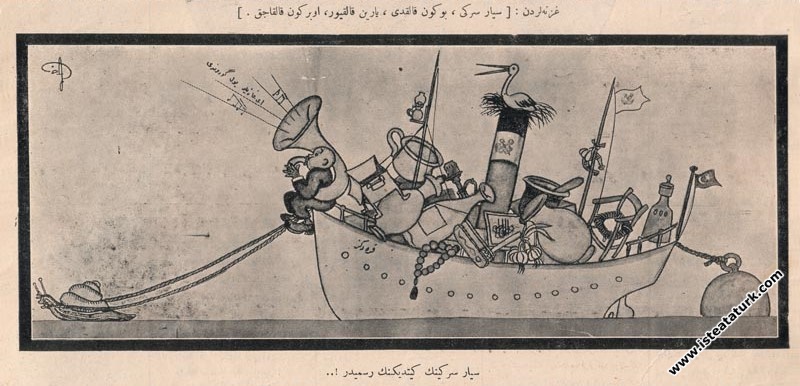
The Black Sea Ferry, which has been criticized for its delay in its movement, is also the subject of a cartoon in Akbaba Magazine.
1926 Atatürk departed from Bursa at 08:00 in the morning and came to Mudanya, and from there to Bandırma with the Black Sea Ship.
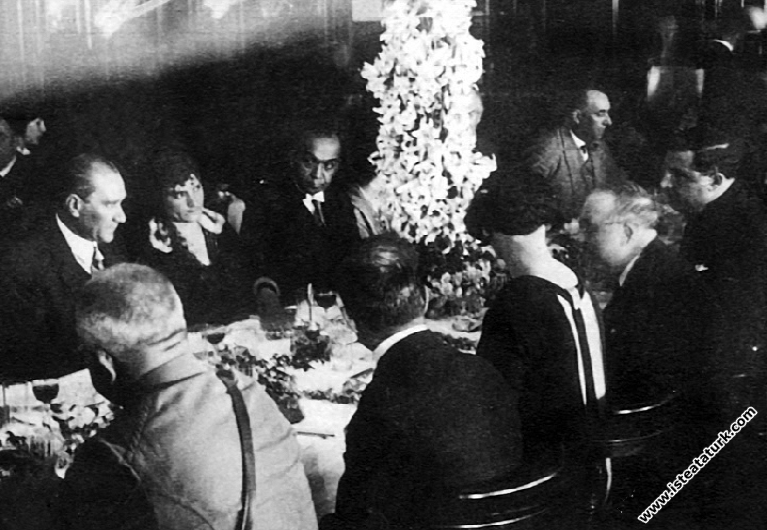
Mustafa Kemal having lunch on the Black Sea Ferry, Mudanya. (June 13,1926)
Atatürk's visit to the traveling exhibition opened on the Black Sea Ferry and what he wrote in the ship's diary:
" The exhibition is a successful work. It made very good impressions on me. The presentation style is very good. I appreciate and congratulate the maker . "
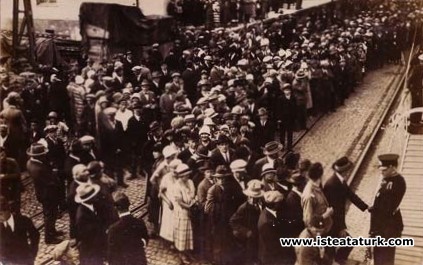
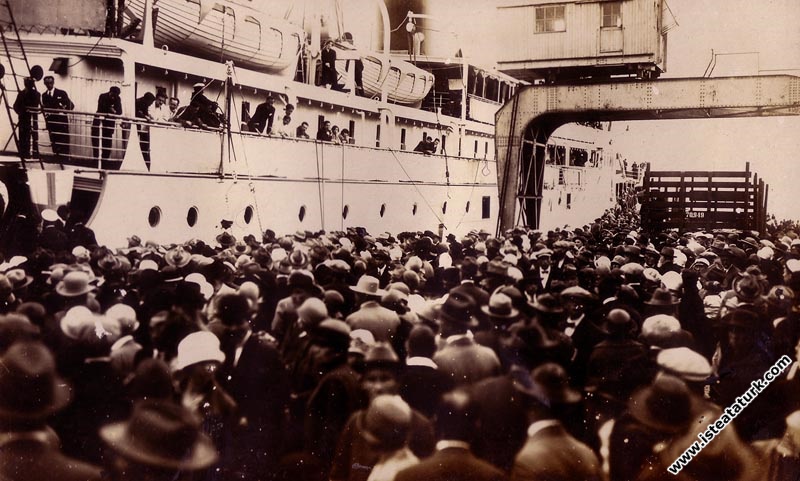
The Mobile Exhibition ship encountered a stampede in most of the ports it visited and attracted great interest from the public.
A NATION INTRODUCES ITSELF
The documentary "Black Sea: The Cruise of Turkey" tells the exemplary story of the mobile exhibition ship that the young Republic of Turkey sent to the great ports of Europe with great devotion.
The Port of Marseille is experiencing one of its historical days. The port, which has always been lively, has been flooded by high society today. A pleasant scent of perfume rises from the beautiful women in "sailor-necked" dresses sewn from white and heavy linen . The long-awaited ship glides into the harbor as the City Band plays the "Marselez" anthem one last time and moves on to an elegant waltz prelude. The white, high-deck, adorned with hundreds of colorful flags, a single chimney, approximately 5 thousand gross tons, is approaching the port.
.jpg)
A moment from the 16 balls held at the ports where the ship stopped.
The French on the quay look at the ship and the flag hung in various parts of the ship. It is a majestic flag embroidered with a white crescent and star on a beautiful red tone. When those on the quay look at the deck, they see the passengers, men and women, leaning on the rail watching them, and cannot believe their eyes. While they expect that the passengers on this ship, coming from Turkey, that is, from the " East" in their opinion , will present an "Orient breeze" , they have a completely different view. This "Oriental" , smiling, waving, looking at themselves from the lower and upper decks guests are no different. The men wore dark suits, sparkling white shirts, and neckties, many of which were embellished with an elegant pin. The women next to them are more stylish than the men. They are dressed in mainly black silk and muslin dresses. Deeply wavy, "alagarson"Her hair, cropped close to a short, shimmers under the Marseille sun. The ship greets the Marseilles with a single long and cheerful whistle. Wooden ladders, the sides of which are supported by ropes, are suspended from the ship and placed on the quay. The French are starting to board the ship. An officer takes them to the showroom. Passing through a winter garden and the hall where a crowded orchestra is playing, the visitors who come to the exhibition section look at the exhibits, unable to speak of admiration. Kütahya tiles with Turkish blue glaze; many embroidered and colorful Ottoman, Yörük, Seljuk and Persian carpets; Hacı Bekir Turkish delights with rose, cinnamon and gum scented; Glass products such as çeşmi nightingale, tulip and rosewood decorated with precious stones such as jade, ruby, and turquoise, all made by hand.

A view from the hall where antique artifacts and objects are exhibited on the Black Sea Ferry.
The date is August 21, 1926. On the side of the ship, in which the French watch the products on display with great admiration, with a crescent-star flag flying on the ship, the words "Black Sea" are written in huge letters, and the young Republic of Turkey, who has just turned three years old, "is doing this to show everyone what a re-created nation can do." for months in Europe's most important ports by ship" is showing the starboard.
.jpeg)
Atatürk's arrival in Bandırma with the Black Sea Ferry. (June 13, 1926)
" BLACK SEA: TRAVEL-I TURKEY"
These things come to life in one's imagination while watching the documentary "Black Sea: Seyr-i Türkiye" at the Ottoman Bank Museum operating under Garanti Bank . Two important projects that will bring a different perspective to Turkey's effort to promote itself are exhibited in the museum building. One of them is the documentary "Black Sea: The Voyage of Turkey" , which tells the adventures of the mobile exhibition ship "Black Sea", which , at Atatürk's request, traveled through European ports in order to introduce Turkey to Europe. The other, "Designing the Nation: European States in the 1920s and 1930s" The exhibition shows the political regimes of that period in the European countries on the route of the Black Sea Ship. The story of the Black Sea documentary, sponsored by Garanti Bank and Netherlands Culture Fund, is also interesting.
Eray Ergeç, a researcher working at the Dutch firm Fatusch, saw the news of a Turkish exhibition ship arriving in the Netherlands in 1926 while scanning the newspaper archives. The news was about the arrival of the Black Sea, the mobile exhibition ship in the port of Amsterdam, which, at Atatürk's request, traveled through European ports to promote the young Republic of Turkey. In time, Prof. from Ankara University Faculty of Communication started to investigate this unknown historical event. Dr. Bülent Çaplı also participated. After two years of work, images, photographs and documents showing the visits of the Black Sea Ferry in European ports were found, and this event, which may have disappeared in the dusty archive of history, was brought to light with the documentary prepared.
While Amsterdam was used for the coordination work of the documentary, the general coordinator of which was Gülay Orhan, Bülent Çaplı and Bülent Özkam carried out their work from Ankara. The script of the documentary was written by Tannur Arat and Nedim Olgun, while the "logbook" sections were compiled from the memoirs of Captain Süreyya Gürsu, Celal Esat Arseven and Orhan Kızıldemir. The documentary, for which Emre Irmak composed the original music, was directed by Soner Sevgi.
.jpg)
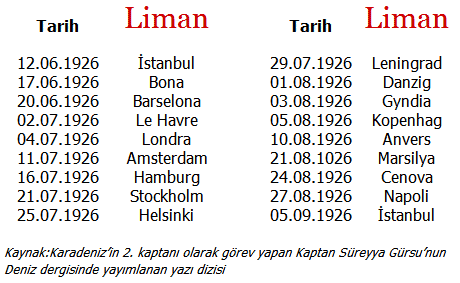
The route map that the Black Sea Ferry will follow on its journey.
EIGHTY-SIX DAYS JOURNEY
Watching the documentary, the Black Sea Ferry, which was taken under special care for three months in the Golden Horn before its European journey, was caught in the wake of the voyage and lasted for eighty-six days. He watches with exemplary and pride how the Republic of Turkey made an extraordinary effort "to introduce friends to foes" and how the three-year-old parliamentarians of the Republic of Turkey struggled to find a source for this. Commerce Deputy Ali Cenani Bey said in the parliamentary chair, “Gentlemen... It is not an easy thing to create a trade exhibition. Instead, I thought of setting up a traveling exhibition. Let's take a ferry from Seyr-i Sefain. For example, the Black Sea Ferry…” He sees the fire created by his speech, his feverish work, and finally, how a white ship, which set off by foaming the pale blue waters of Marmara, was sent off on a yacht in Dolmabahçe by a blonde man waving a white handkerchief, with flashing blue eyes. Those who think that that blond man made such a ferry trip to Samsun to save the country seven years ago on May 19, 1919, are also proud to see how a republic was born.
Source: Lemi Özgen SkyLife Magazine - February 2007
Photo credit: Lemi Özgen SkyLife Magazine - February 2007
II
BLACK SEA FERRY
The year is 1926... It's June 12... The place is today's Tophane Pier... It is seen that double-horse phaetons are waiting for passengers next to the taxis... A white ferry, armed with flags, is getting ready for departure... The Seyr-i Sefain Administration has just bought it. this Black Sea ship is about to embark on a very important voyage... In this trip, which will last for about three months, samples of our handicrafts and our leading products will be introduced... But the main aim is to introduce the young Turkish Republic to Western European countries! During the exhibition expedition organized with this intention, the ship will stop at the ports of 12 European states and stay for three or five days each.
.jpg)
Black Sea Ferry, the place is Tophane dock. (June 12, 1926)
If you do not count the Bona (later known as Anaba) Port of Algeria, which he will enter to buy coal, look at which ports he will call; Barcelona, Le Havre, London, Amsterdam, Hamburg, Stockholm, Helsinki, Leningrad, Danzig, Gdynia, Copenhagen, Antwerp, Marseille, Genoa, Naples...
Visitors who want to visit our ship will be accepted at every port... Invitations and receptions will be given... The Presidency of the Republic will also give concerts on the ship... The members of the balls will be brought together with the visitors... It will introduce the Turks of the Republic of Turkey.
The cavalryman of the ship is the famous Lütfi Captain, nicknamed Topuz , who is famous for being a capable sailor despite his young age. While he was the cavalryman of Gülcemal a few years ago, he now serves on the Black Sea Ferry. All of the young officers on the ship are especially bright young sailors... In the future, all of them will be captains or managers of the ships of the Maritime Lines as great captains.
Black Sea Ferry 1905 Dutch made. 4,765 gross tons. It is 120 meters long and 14 meters wide. At full throttle, it accelerates to 12 mph. It was specially arranged and decorated for the exhibition from start to finish.
This historical trip, which has been mentioned for years, takes 86 days and 22 hours. The day he returned to Istanbul, the calendars show September 5th. Traveling a total of 9,981 miles, the ship consumed 2,778 tons of coal during this long voyage. The amount of fresh water used is 971 tons.
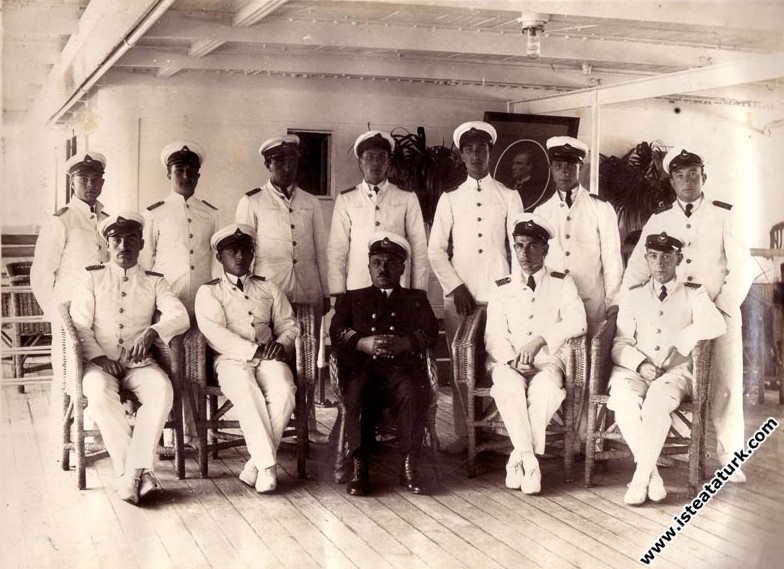
The captains and crew of the Black Sea Ferry
The contribution of this exhibition expedition to the promotion of Turkey was really great. Very good news about Atatürk's Turkey appeared in the press of every country the ship went to, and very valuable writers were published. It should never be overlooked that the Seyr-i Sefain Administration played an important role in this great success.
Continuing to carry passengers on domestic and international routes for years, the Black Sea served uninterruptedly until it became a 46-year-old ship. In the 1950s, when our merchant fleet began to be reinforced with newly purchased ships, it was dismissed and tied aside in 1951. Scrapped in 1954 and dismantled in Genoa.
If only we could equip such a ship today and take it on a long voyage around the world for this purpose...
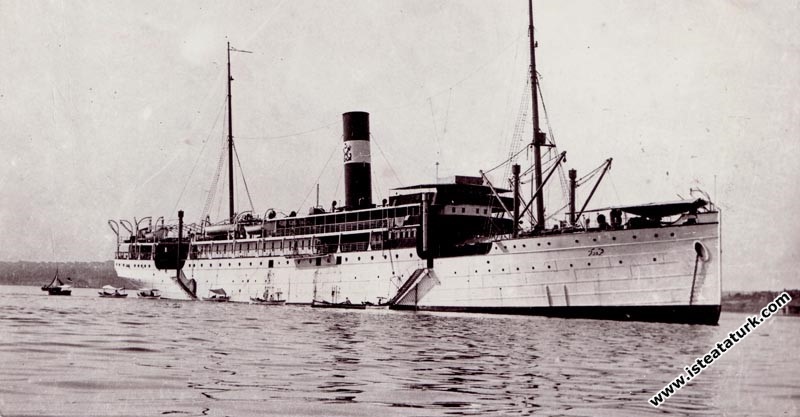
Before the journey, the Black Sea Ferry was taken to the Golden Horn, underwent maintenance for three months and was painted white.
Source: Istanbul's Unforgettable Ships, Eser Tutel
Additional info:
80 years ago, the Black Sea Ship was turned into a "floating exhibition" and taken on a European cruise. The aim was to introduce Turkey to the West.
What was not on display on the ferry: Tobacco, Kütahya tiles, Haci Bekir Turkish delight, Bursa and Hereke fabrics... The Presidential Orchestra was on the ship departing from Galata on 12 June 1926.
The floating exhibition, which was first anchored in Barcelona Harbor, was visited by 11,000 Spaniards in three days. The Black Sea Ship had stopped at 16 ports in 12 countries, including France, England, the Netherlands, and Germany.
One of the interesting exhibits on the ship, which returned to the country after 86 days, was undoubtedly the Angora goats!
